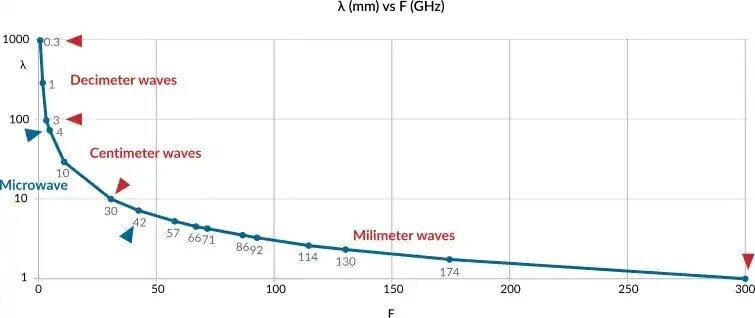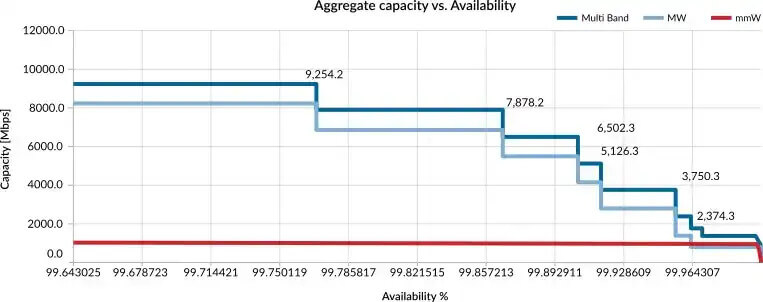×
CONTACT US
CONTACT US
5G wireless backhaul, or as some refer to it , wireless transport, is a means for connecting broadband sites to the core network in a wireless manner. In the case of mobile networks, this is a common way to connect a radio access network (RAN) tail site (e.g. a base station, eNodeB/eNB or gNodeB/gNB) to the core of the mobile network – without the need to deploy optical fiber. It is used when high-speed wireline connectivity to telecom sites (typically via fiber optics) is unavailable, when rapid deployment is required, and when a cost-efficient solution is needed. In fact, according to a 5G Microwave Report, about 38% of all global telecom sites will be connected to the rest of the network via wireless backhaul, by 2025.
There are many types of wireless backhaul, which can be categorized according to several parameters:
which typically provide wireless link capacity of up to 20 Gbps, are used in the access and aggregation backhaul segments over short distances ranging between several hundred feet to 10 miles. Short-haul links deployed in access applications (macrocells and small cells) wirelessly connect individual base stations and cellular towers to the core network.
which also provide multi-Gbps capacity, are used in the “highways” of the telecommunication backbone network. These links are used to carry services at distances of 10 to 100 miles, and, using the right planning, configuration and equipment, can also bridge distances of over 150 miles.
Long-haul microwave links often use a multicarrier configuration, grouping 4, 8 and even 16 carriers into a single link. Such configurations utilize the same antenna with a branching system and implement space diversity techniques to avoid fading and maintain availability targets. When implementing multicarrier configurations, traffic distribution engines, such as Ceragon’s multicarrier Adaptive Bandwidth Control (ABC), dynamically adjusts the traffic sent over each carrier to accommodate the available capacity of the carrier.
Wireless backhaul systems can be classified according to the following frequency bands:

These frequencies are typically used for long-haul connectivity. While these frequencies excel in propagation, they typically bear higher fees and channel width availability is rather low (from 28/30 MHz to 56/60 MHz and, in rare cases, 112 MHz).
These frequencies are typically used for short-haul connectivity. The higher bands within the range often make wider channels available – 112 MHz and even 224 MHz.
Engineering-wise, millimeter waves or widebands, reside in the 30-300 GHz range. When discussed in the context of wireless transmission, these refer to bands of 57 GHz and above. Millimeter waves have evolved as an extremely cost-effective solution for ultra-high-speed connectivity for short ranges. The 57–66 GHz band is referred to as V-Band. The 71–76 and 81–86 GHz bands are referred to as E-Band. W-Band refers to the spectrum around 100 GHz, and D-Band refers to the frequency range of 130-175 GHz. Different uses of V-Band and E-Band are based on the propagation characteristics of the two bands and the available distance derived from them. V-Band has a much shorter range and is typically used for intra-campus connectivity, surveillance camera infrastructures or small-cell backhaul. E-Band has a significantly higher range and can be used for business customer access, cell site connectivity or fiber backup. Generally, the higher the frequency band and the wider the channel, the greater the throughput. In E-Band, wide channels are available, with channel spacing ranging from 62.5 MHz up to 2000 MHz (or 2 GHz). It can handle 10 Gbps using a single 2 GHz channel.

E-Band implementation is more challenging for longer links due to high attenuation, which results in reduced availability. Multiband resolves this challenge by combining a microwave carrier with an E-Band carrier, thus achieving both high capacity and high availability for longer distances.

Two main architectures can be used by service providers to implement wireless transmission connectivity: point-to-point (PtP) and point-to-multipoint (PtMP).
PtP backhaul architecture consists of two nodes communicating only with one another, and is a line-of-sight (LOS) radio transmission technology. PtP wireless links can range from short-range links connecting two locations just a few hundred meters apart to long-range wireless links that connect two locations tens of miles away from each other.
PtMP architecture uses a single hub to create a sector of coverage that can backhaul multiple sites. A PtMP link consists of at least one base station (BS) radio linked to several subscriber unit (SU) radios. PtMP links typically use lower licensed or license-exempt frequency bands that allow for operations in near-line-of-sight (nLOS) and even non-line-of-sight (NLOS) conditions. PtMP solutions excel in terms of ease of deployment, while PtP solutions benefit from capacity scalability.
Some of today’s backhaul networks, primarily in emerging markets, still employ circuit-switched (or TDM) solutions, whether T1/E1 or high-capacity SDH/SONET. These networks, originally designed to carry voice-only services, have limited bandwidth capacity and offer a non-cost-efficient scalability model.
Today’s surge in mobile data usage is fueled by anticipation and adoption of advanced releases of 4G and 5G services. This surge is driving operators to accelerate and finalize the migration of their networks to a more flexible, feature-rich and cost-optimized IP network architecture. Additionally, the surge in data usage in densely populated areas is driving operators to explore new network architectures. Such architectures utilize a variety of small-cell technologies requiring the deployment of dense wireless backhaul networks in various microwave and millimeter-wave spectral bands.
In order to ensure the success of these network strategies, operators require solutions that can support any network architecture for backhaul, including both all-IP and hybrid (IP and TDM) service connectivity.

Wireless backhaul is the fastest and most cost-effective way to connect new sites to the network. But not all wireless backhaul solutions are created equal, and they don’t all provide the same benefits. It’s critical that various node configurations come with optional migration from TDM to Ethernet and include integrated networking functions for both TDM, Ethernet and IP/MPLS.
Traditionally, wireless backhaul solutions offer several form factors, or functional splits, for their networking and radio elements. In general, there are four types of wireless backhaul configurations: disaggregated, all-outdoor, split-mount and all-indoor.
Disaggregated wireless hauling includes several elements that are independent of each other. The radio element can be a stand-alone radio or can connect to L2 switches or L3 routers. These switches or routers can be a combination of the networking HW and networking SW elements, or any other switching or routing platform. This cannot be achieved in a proprietary environment, where development of the radio, networking HW and networking SW are highly dependent on each other.
With the all-outdoor configuration, both the networking function (which is all-IP) and the radio function are outdoors, in a single box, mounted to the antenna or tower.
The split-mount configuration splits the node functionality into a networking element that is installed indoor, and a radio element that is mounted to an antenna (direct mount) or to the tower (remote mount) connected with waveguides to the antenna.
In the all-indoor configuration, both the networking element and the radio element are installed indoors. The radio is connected to the external antenna with a long waveguide.
The benefits of using all-outdoor wireless backhaul solutions, compared to split-mount and all-indoor solutions, are significant:
Utilizing all-outdoor solutions eliminates the need for indoor rack space for the networking unit. In cases where the other equipment at the site (e.g. RAN equipment) is also in an all-outdoor configuration, there is no need for a shelter – making site allocation and acquisition simpler, faster and more cost-effective.
Since the node is based on a single box that covers all functionality (radio and networking), the number of part numbers in the network is reduced significantly.
All-outdoor solutions allow lower power consumption. First, the direct consumption of the unit is significantly lower. On top of that, the lack of an indoor unit eliminates the need for an air conditioning system. The saving is both in the A/C system itself and in its power consumption, which is typically half the power consumption of the unit it needs to cool.
The fact that the active equipment is installed high above the ground leads to additional security. Attackers (e.g. vandals) need to use extreme measures to physically reach the equipment in order to sabotage it.
An architectural revolution in 5G RAN allows massive horizontal disaggregation of the classic base station as it splits its functionality to three separate functions: the central unit (CU), the distributed unit (DU), and the radio unit (RU).
Bringing huge flexibility, scalability and performance improvements to network operators, this disaggregation also creates several possible RAN architectures, which can all be implemented in different parts of the same network. These architectures include: (1) cell site RAN, in which all three functions are co-located (the “classic” cell site architecture); (2) split RAN, in which the DU and RU are co-located and the CU is located in a central location; (3) central RAN, in which only the RU is deployed in the tail sites while the CU and DU are centralized; (4) and dual split RAN, in which each of the three functions is located in a different site.
These architectures introduce connectivity types or segments that did not exist in previous generations, like midhaul (between the CU and DU) and fronthaul (between the DU and RU). Both of these segments are actually an integral part of the RAN architecture (as opposed to backhaul, which connects the RAN to the network’s core).
Choosing split, central or dual split architecture is typically done as part of network densification that calls for more cell sites. Midhaul and fronthaul have new low latency requirement as those transmission segments are actually a part of the base station.
Fronthaul describes the connection between the cell tower radio itself (remote radio head or RRH) and the mobile network control backbone (the baseband unit or BBU). CPRI is a well-known standard for this interconnection. The main driver behind fronthaul is the need to deploy a lot of new sites, particularly in dense urban areas. The growing demand for capacity in Gigabit LTE and 5G networks, and the use of higher frequency bands for 5G NR with a much shorter range between the cell site and the mobile device, will undoubtedly require significantly more cell sites.
Fronthaul capacity is the major challenge of deploying distributed cells within the centralized or cloud RAN (C-RAN) architecture. In the 4G realm, a 10 Gbps connection might be enough to support some fronthaul scenarios. But when it comes to 5G, using higher frequencies bands and dealing with much wider challenges in the RAN inflate fronthaul capacity, and challenges the current fronthaul scheme (based on protocols such as CPRI and OBSAI). With the current protocols, the fronthaul capacity per RRH, using wide channels (up to 500 MHz) at the RAN, accumulates to 10s and even 100s of Gbps.
To fully leverage the benefits of distributed cells in terms of cost savings and fast time to market, new wireless fronthaul schemes allow operators to deploy RRHs in sites where fiber is not available. The deployment of high-capacity and ultra-high-capacity point-to-point wireless links represents a scalable, flexible and cost-effective alternative for expanding fronthaul capacity. Supporting fronthaul data rates of 10 Gbps and above over a single radio unit, wireless hauling solutions enable cellular operators to add capacity only as required while significantly reducing upfront and ongoing fronthaul costs.
Regulated, or licensed, microwave bands (4-42 GHz) and millimeter-wave bands (71-86 GHz) are allocated by government licensing authorities for high-capacity wireless transmissions. The license grants the licensee the exclusive use of that spectrum for a specific use, thereby eliminating any interference issues. A licensed microwave or millimeter-wave spectrum is typically the choice of leading operators around the world since it provides the bandwidth and interference protection they require.
Service providers also select license-exempt spectrum to provide high-speed connectivity to businesses and campuses (often regarded as wireless backhaul). Such spectrum also can serve small cells with wireless backhaul connectivity, without regulatory approval for spectrum.
License-exempt spectrum can be categorized into two main categories:
Known as V-Band, this millimeter-wave spectrum operates at very wide channel bandwidths up to 2,000 MHz, and is capable of delivering 10 Gbps bidirectional capacity (FDD). The use of V-Band spectrum requires the existence of a line of sight between the sites. V-Band allows the achievement of high-availability connectivity due to the narrow beam characteristics of the radio signal, and provides the highest capacity when operating in a point-to-point communication mode.
Operating at narrow channel bandwidths of up to 80 MHz, this spectrum delivers up to 500 Mbps bidirectional capacity (FDD), typically in point-to-multipoint network architecture. The use of sub-6 GHz spectrum allows for non- or near-line-of-sight connectivity between sites, and facilitates a cost-effective and flexible rollout model, at the expense of providing modest capacity.
License exempt V-Band and sub-6 GHz bands are more vulnerable to interference as a result of the uncoordinated use of the spectrum.
While there are slight variations from region to region, in general most countries have implemented a per-link licensing approach that requires links to be individually coordinated and interference to be managed by the regulator.
For traditional bands above 18 GHz, several countries are adopting the so-called block spectrum or individual licensing approach. According to GSMA, block spectrum licensing represents about 21% of license models in operation worldwide.
Block spectrum licensing is usually acquired for the 23-28 GHz bands in Europe and the 31 GHz band in the United States. Italy allows block allocation in the 26 GHz and 28 GHz bands, and they are not shared. Hungary also uses the 26 GHz band. France uses the 23 GHz, 26 GHz, 32 GHz and 38 GHz bands. And South Africa has allocated spectrum in the 26 GHz, 28 GHz, 38 GHz and 42 GHz bands.
As mentioned previously, V-Band is defined as a license-exempt frequency. V-Band does not require coordination and theoretically can face severe interference. In practice, due to the very high atmosphere attenuation in this band, the chances of interference are low.
As for E-Band, the situation is a bit different, with a growing number of countries using self-coordinated, light-licensed approaches. The US, the UK, Russia, Hungary, Nigeria, India, Qatar, and Australia are among those countries that have opened up this spectrum on a self-coordinated basis.
Unlike per-link licensing, both block spectrum licensing and the self-coordinated/light-licensed approach give operators more freedom by taking responsibility for assigning and coordinating links without restrictions.
Copyright © Ceragon | Terms & Conditions | Privacy Policy